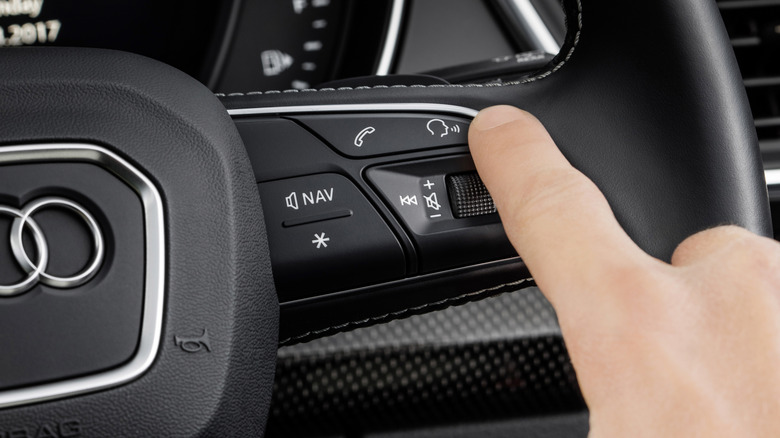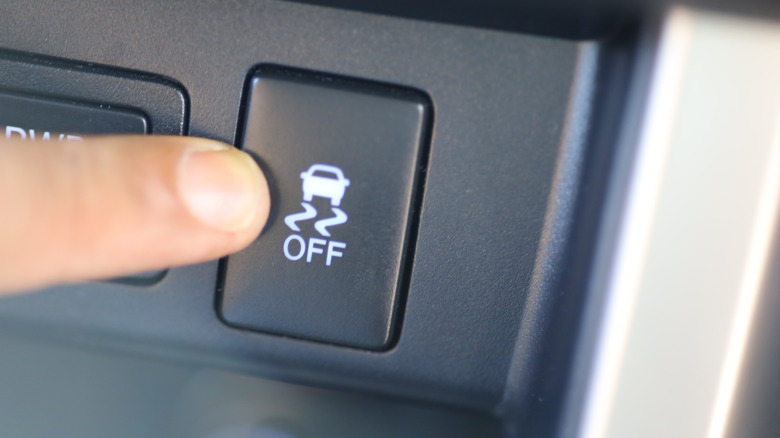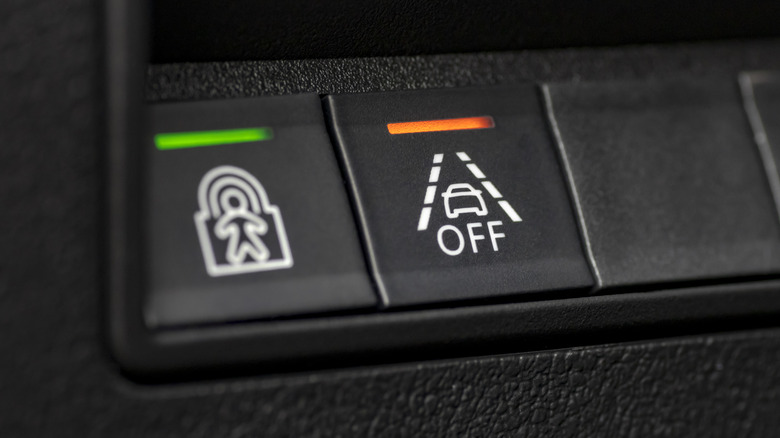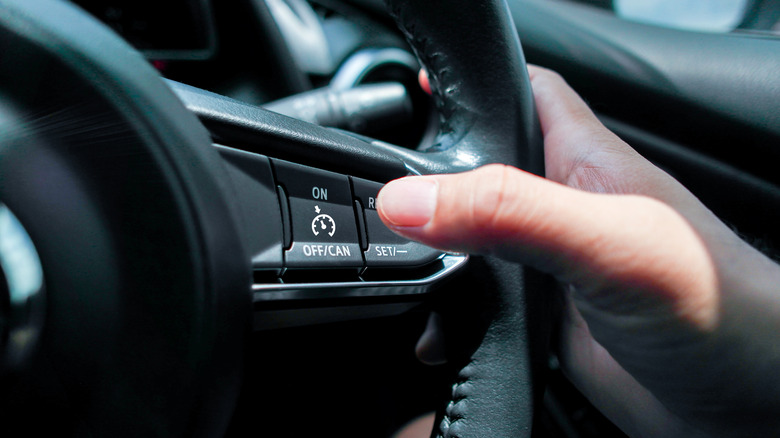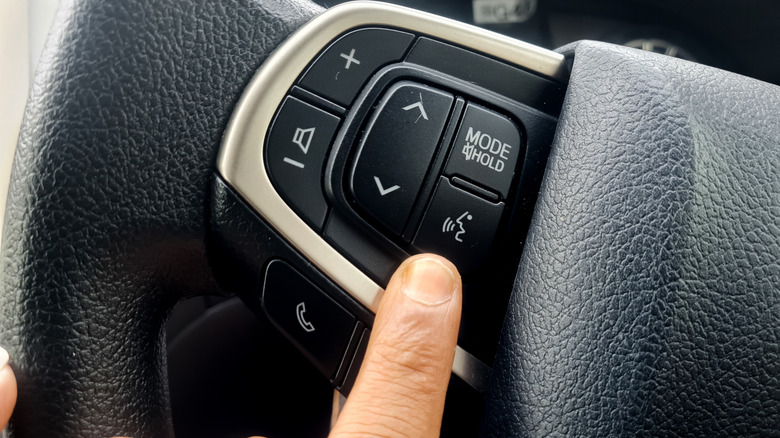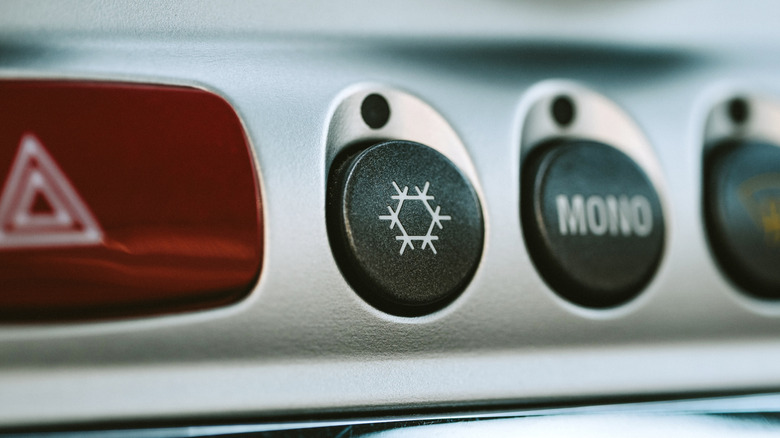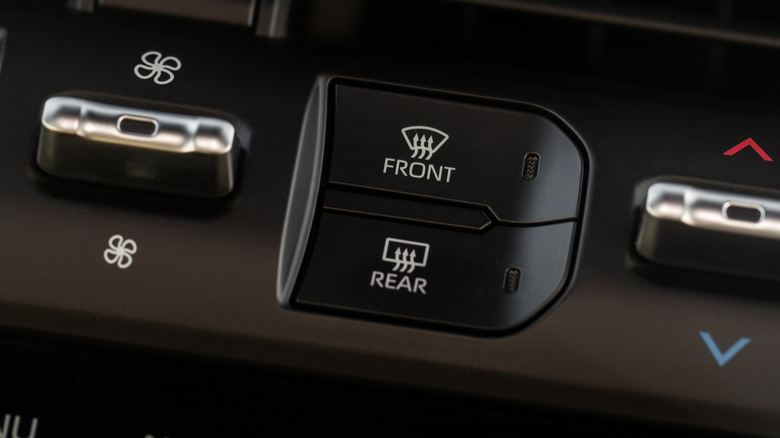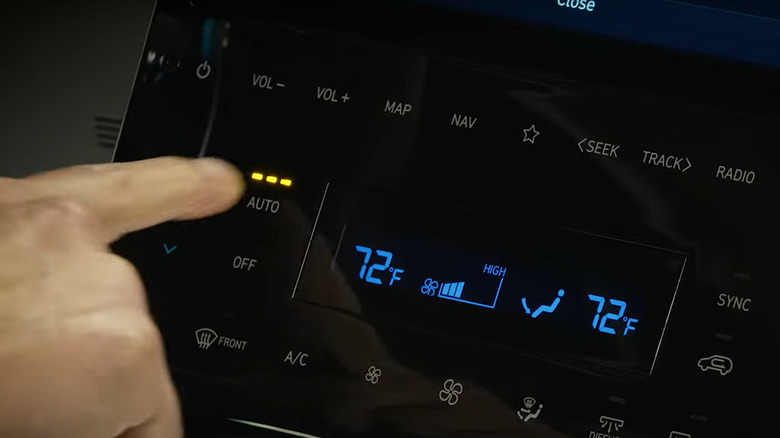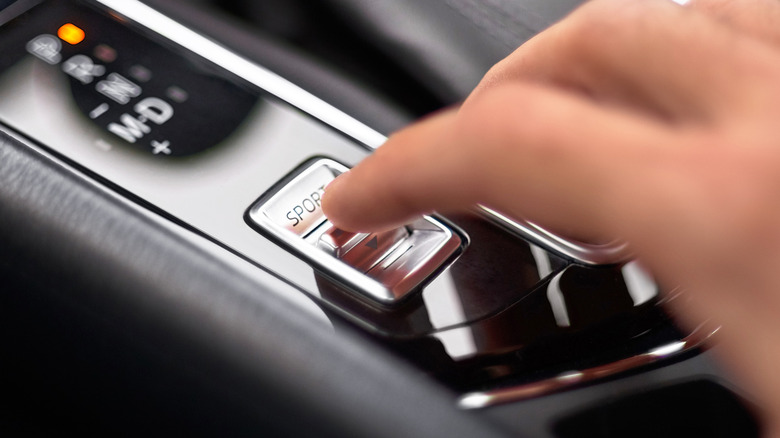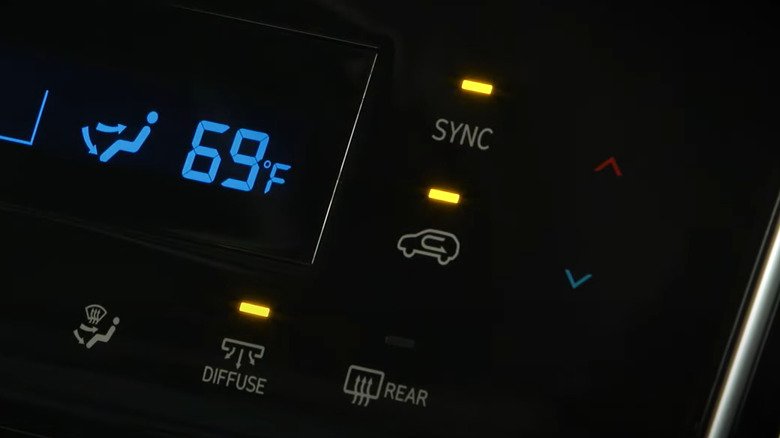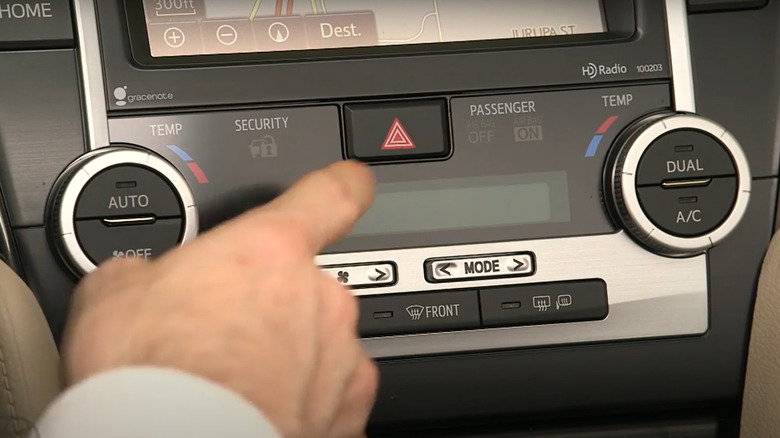10 Common Car Buttons (And What They Do)
If you're buying a new car, there's a lot to wrap your head around. Sorting out financing, legal paperwork, and insurance can be exhausting, and by the time they actually get into their new car, many people just want to hit the road and start driving. However, taking some time to get comfortable with a new car's interior buttons and switchgear before you set off can make all the difference. In particular, learning what the symbols on each of the buttons mean saves the hassle of trying to work it out on the go.
The appearance, layout, and symbols on each button will vary between different car manufacturers and models, but there are a few common buttons that can be found across many cars, both old and new. Whether you're looking to get the best out of a new car or wanting to refresh your memory after some time away from the wheel, we've put together a roundup of common buttons that are found in many popular car models, alongside a quick rundown of what they all do.
Traction control button
Although a traction control button can be found in most cars, in the vast majority of driving situations, it's probably best to leave it alone. Traction control is turned on as standard, and turning it off disables one of the car's key safety systems. Its purpose is to help keep the car under control if one wheel starts to slip, preventing the car from losing grip entirely and entering a slide. If the system detects that one wheel is moving significantly faster than another, it can temporarily cut power to that wheel to help it regain traction. When the system engages, the traction control warning light will appear on your car's dashboard temporarily, and you might feel the car judder a little as it cuts power to the wheel.
Traction control became standard on all new cars after 2012, but it can also be found on many models manufactured before then. Turning the system off lets the wheels spin freely, which can be dangerous if you lose grip while on the road. However, there are a handful of situations where turning it off might be useful, such as if you're stuck in snow or mud. In either of those cases, it might be beneficial to let the wheels spin to push the car forward or backward slightly. Once you're out of the slippery patch, make sure to turn the system back on again, since it's a useful safety feature in almost every other situation.
Lane departure warning/lane keeping assist button
Most new and recently manufactured cars have a lane departure warning system to let drivers know if they drift out of their lane while on the road. Most systems use a camera to monitor the road ahead and will issue the driver an alert if the car starts to move out of its lane without signaling or steering. Many newer cars also pair this with a lane keeping assist function, which can automatically adjust the steering to keep the car in the lane if the driver doesn't respond.
While it's a useful feature to have, particularly on long road trips or early morning commutes, it's not foolproof, and in some cars, it can occasionally trigger false alarms. Sun glare, unclear road markings, bad weather, and obstacles like tunnels are all known to cause issues with some lane departure warning systems, so it's worth knowing how to turn it off in your car.
Most cars equipped with the feature have a dedicated lane departure warning/lane keeping assist button, which looks like a car traveling between two lines. It can often be found on the steering wheel. Pressing and holding the button will usually turn the system on or off, but the exact function will vary between car makes, models, and the type of system your car is fitted with. Like all the buttons here, the best way to check exactly how your car's system works is to read the owner's manual.
Cruise control button
One of the oldest driver assistance systems is cruise control, which has been around since 1948. The story goes that its inventor, Ralph Teetor, was in a car being driven by his lawyer, who kept absentmindedly changing the position of his foot on the accelerator while having a conversation. This resulted in the car constantly changing speed, leading Teetor to devise a system to keep a car at a steady speed without needing to use the accelerator.
The basic function of cruise control remains unchanged today, although many modern cars now have adaptive cruise control that can help maintain a steady distance from the car in front. As well as keeping the car at a constant speed, there's plenty of evidence that it can help use less fuel in many driving situations. Turning the system on and off is usually done via a button located on the car's steering wheel.
Voice command button
Many cars have some kind of voice control system, although the specifics will vary from car to car. Some systems rely on the voice recognition features of Apple CarPlay and Android Auto, and require a smartphone to be connected to the car in order to function. In other cases, manufacturers have their own built-in systems that can be used independently. The trigger for voice commands will also vary between manufacturers. While some can be activated by saying a trigger phrase — BMW's is "Hey BMW," for example — others require the driver to push a button to get the car to "listen" to a command.
Manufacturers like Mazda and Toyota produce popular car models that rely on voice command activation buttons, usually marked with a symbol that looks like soundwaves coming out of a person's mouth. On some Mazdas, the same button can also be used to pick up calls if the car detects one is incoming. Once the system has processed the request and begins to give the driver a dialogue response, that dialogue can sometimes be canceled by pressing the button down again.
Snowflake button
Not all cars will have a button with a snowflake symbol, and those that don't might instead have a button marked "A/C." The function of both is the same — pressing it will turn on the car's air conditioning compressor pump. This pump circulates cool air around the car, complementing the work of the fans, which are operated separately. Enabling the A/C can potentially result in a drop in fuel economy, but it's the best way to keep the cabin cool on a hot day.
According to an explainer by Ford, it's generally more fuel-efficient to keep the windows up and the A/C on during highway driving, as the added drag from keeping the window open will result in a bigger drop in fuel economy than using the A/C. On urban and suburban roads at lower speeds, it's generally more efficient to roll the windows down and leave the A/C turned off.
In many cases, the A/C button does not reset after the car is turned off and on again, and so it will need to be manually turned off once you finish your journey. If you turn the button on and find the A/C doesn't blow cold, it might need regassing, or there might be a problem with a component in the system. Either way, it's best to get it checked out.
Rear window defroster button
Unlike some other buttons, there's no single, commonly agreed-upon place within a car's dashboard layout where a rear window defroster can usually be found. Instead, you'll need to look for the logo — which stays very similar across most modern cars — on a button that could be anywhere between the side of the steering wheel and the center console. Most will feature a small light within the button that illuminates when the defroster is on.
Modern defroster systems work by pumping electrical current to small wires embedded within the car's rear window, which heat up and melt the ice coating the window's surface. Most systems will eventually turn themselves off after a set period, so unlike the A/C, you shouldn't need to worry about remembering to turn off the defroster after you've turned it on. Turning the car off will also automatically turn off the rear window defroster.
Auto climate control button
If you spot a button near the climate controls that simply reads "Auto," it means your car has automatic climate control. It's the simplest way to keep your car at the temperature you want it — just set the desired temperature, press the Auto button, and the car's system will work to maintain that set temperature. The system will automatically control the car's fan speeds, the level of cabin air intake, and the A/C, and will increase its cooling capacity if it detects that the cabin is exceeding the target temperature.
Some cars also feature multiple climate control zones, so the driver and passengers can set different target temperatures. To reset each individually configured climate zone and revert to a single target temperature for the whole car, a separate "Sync" button can usually be found near the "Auto" button. An indicator light is usually built into each button so drivers can see at a glance which features are enabled.
Sport mode button
Many cars have a sport mode button, although exactly what it does varies a lot between different models. Some performance cars offer multiple types of sport mode and let drivers individually customize how the mode changes a car's responsiveness, but in most common cars, it just tweaks a few settings to make the car feel sharper to drive. Usually, these tweaks involve making the throttle more responsive, changing the weighting of the steering, and if a car has adjustable suspension, tightening it up for a firmer feel on the road.
Often accompanying sport mode is an eco mode button, which has roughly the opposite effect. While sport mode focuses on responsiveness at the cost of fuel efficiency, eco mode prioritizes saving fuel above all else and often restricts the car's maximum power. Some cars offer numerous driving modes and don't always feature buttons to switch between them. Instead, they can be switched via a touchscreen menu, knob, or some other kind of physical control.
Recirculation button
While the design varies between manufacturers, most air recirculation buttons have a logo that features a curved arrow turning 180 degrees inside the silhouette of a car. The button forms part of your car's climate control system and controls whether the air pushed through the ventilation system is drawn from inside or outside the car. If it's pulled from outside, it can also bring smoke and smells from the nearby environment into the cabin. Outside air can also make an A/C system work harder if it's particularly hot, and turning on recirculation should help a hot car cabin cool down faster.
However, on less hot or highly humid days, it's advisable to leave the recirculation turned off. Leaving moist air to circulate around the cabin repeatedly can cause fogging and can also leave unpleasant smells trapped inside the car. So, having the option to either recirculate air or let in a fresh air stream is certainly useful, but it isn't always needed. If you have your air conditioning set to Auto, the car's system will usually take care of deciding when it's best to use recirculation automatically.
Hazard light button
While it's (hopefully) among the buttons you'll need to use the least often, it's critical to know where the hazard light button is in your car so you can use it in an emergency. Engaging the hazard lights will flash all of a car's turn signals at once, letting drivers around you know that something is wrong and that they need to be especially aware of your car. The hazard light button features a distinctive triangle design and will usually be placed somewhere obvious so it can be pressed at a glance.
It's also worth knowing when not to use your hazard lights. They shouldn't be turned on in bad weather unless your car is broken down or otherwise stationary, and certainly shouldn't be used to park in places you're not supposed to. Laws for when to use hazard lights vary by state, with the strictest states dictating that you shouldn't use them while the car is driving under any circumstances. So, it's important to check the laws of your state before you hit the road.
